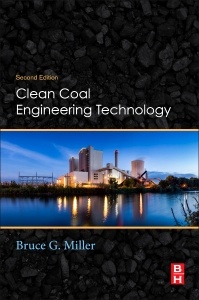Clean Coal Engineering Technology (2nd Ed.)
Auteur : Miller Bruce G.

Clean Coal Engineering Technology, Second Edition provides significant information on the major power generation technologies that aim to utilize coal more efficiently, and with less environmental impact. With increased coal combustion comes heightened concerns about coal?s impacts on human health and climate change, so the book addresses the reduction of both carbon footprints and emissions of pollutants, such as particulate matter, nitrogen oxides, and mercury.
Part 1 provides an essential grounding in the history of coal use alongside coal chemical and physical characteristics, worldwide distribution, and health and environmental impacts. Part 2 introduces the fundamentals of the major coal utilization technologies and examines the anatomy of a coal-fired power plant before going on to provide an overview of clean coal technologies for advanced power generation. Next, users will find a group of chapters on emissions and carbon management that have been extensively enlarged and updated for the second edition, thus reflecting the ever-increasing importance of this area.
The final section of the book focuses on clean coal technology programs around the world and the future role of coal in the energy mix. This fully revised and selectively expanded new edition is a valuable resource for professionals, including environmental, chemical, and mechanical engineers who seek an authoritative and thorough one-volume overview of the latest advances in cleaner power production from coal.
PART I – BACKGROUND INFORMATION
Chapter 1. Introduction to Coal
Chapter 2. Coal as Fuel
Chapter 3. The Effect of Coal Usage on Human Health and the Environment
PART II – COAL UTILIZATION TECHNOLOGIES
Chapter 4. Introduction to Coal Utilization Technologies
Chapter 5. Anatomy of a Coal-Fired Power Plant
Chapter 6. Clean Coal Technologies for Advanced Power Generation
PART III – EMISSIONS AND CARBON MANAGEMENT
Chapter 7. Coal-Fired Emissions and Legislative Action
Chapter 8. Particulate Formation and Control Technologies
Chapter 9. Sulfur Oxides Formation and Control
Chapter 10. Nitrogen Oxides Formation and Control
Chapter 11. Mercury Emissions Reduction
Chapter 12. Formation and Control of Acid Gases, and Organic and Inorganic Hazardous Air Pollutants
Chapter 13. CO2 Capture and Storage
Chapter 14. Emerging Technologies for Reduced Carbon Footprint
PART IV – CLEAN COAL TECHNOLOGY PROGRAMS AND ENERGY SECURITY
Chapter 15. U.S. and International Activities for Near Zero Emissions During Electricity Generation
Chapter 16. The Future Role of Coal
PART V – SUPORTING INFORMATION
Appendix A: Regional Definitions
Appendix B: Coal-Fired Emissions Factors
Appendix C: List of Hazardous Air Pollutants
Appendix D: International Emissions Standards
Professional engineers in the power generation sector, environmental engineers, chemical engineers, mechanical engineers, pollution control specialists interested in coal power plants. Undergraduate and graduate students and faculty in energy/power engineering courses.
- Provides a thorough, yet readable, one-volume guide to advanced power generation technologies for cleaner electricity production from coal
- Retains the essential background information on coal characteristics and the fundamentals of coal-fired power generation
- Presents extensively expanded and updated coverage on technologies for the reduction of pollutants, including particulate matter, sulfur oxides, and mercury
- Emphasizes carbon capture methods, storage, and emerging technologies for the reduction of carbon footprints, alongside a discussion of coal’s future in the energy mix
Date de parution : 10-2016
Ouvrage de 856 p.
19x23.3 cm
Thèmes de Clean Coal Engineering Technology :
Mots-clés :
Clean coal; Thermal power plant; Fossil fuel; Power plant engineering; Electricity generation; Carbon emissions; Greenhouse gas emissions; Pollution control; Energy efficiency; Advanced ultra-supercritical coal power plants; A-USC; Oxyfuel combustion; Calcium looping; Chemical looping; Integrated gasification combined cycle; Fluidized bed combustion; IGCC; Carbon capture and storage; CCS



